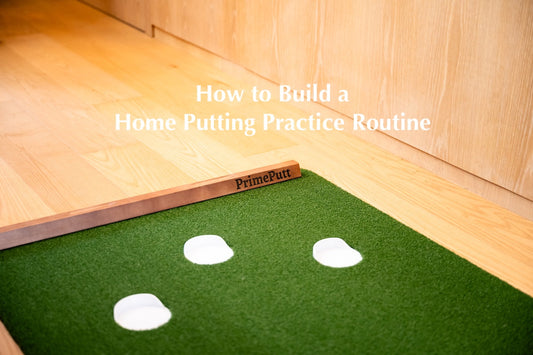I've heard every excuse in the book about why golfers can't practice their putting. "I don't have time to get to the course." "My apartment is too small." "The kids are always running around." Trust me, I get it. Life happens, and finding time for golf practice can feel impossible some days.
But here's something that might surprise you: some of the best putters I've coached over the years have built their skills right in their living rooms, bedrooms, and even office spaces. You don't need a massive home or hours of free time to dramatically improve your putting. What you need is a smart approach, simple (yet effective) at-home putting drills, and the willingness to get a little creative with your space.
Let me share what I've learned from working with busy professionals, parents juggling soccer practices, and retirees living in cozy condos. The secret isn't having the perfect setup—it's making the most of whatever space and time you've got.
Start With Your Space Reality Check
Before you start moving furniture around, take an honest look at what you're working with. I've seen incredible putting improvements happen in spaces as small as six feet by three feet. That's smaller than most people's bathrooms, yet it's plenty of room to work on the fundamentals that matter most.
The key is identifying your "putting zone" and making it sacred. Maybe it's that hallway between your bedroom and bathroom. Perhaps it's a corner of your home office where you can roll back the chair. I once had a student who practiced exclusively on his apartment balcony. The result? He dropped four strokes off his handicap in six months.
Your space doesn't need to be permanent either. One of my favorite success stories involves a busy executive who kept a putting mat rolled up behind his office door. Every day during his lunch break, he'd unroll it and spend fifteen minutes working on his stroke. By the end of the season, he was sinking putts his buddies couldn't believe.
The Foundation: Investing in Quality
Here's where I'm going to save you some money and frustration. I've tested dozens of putting mats over the years, and most of them aren’t going to help you get better (Check out a few of my recent reviews: PrimePutt vs. Big Moss and PrimePutt vs. Perfect Practice). They either roll too fast, too slow, or have that artificial bounce that engrains terrible habits that do not translate to the actual golf course.
The PrimePutt mat is hands down my best suggestion for creating a true roll green experience at home. The ball reaction is remarkably similar to what you'll find on actual greens. The investment pays for itself quickly when you consider the costs of range time and green fees.
What makes a quality mat worth it? Consistent roll characteristics, proper speed, and durability. Cheap mats develop bumps and inconsistencies that actually hurt your putting more than help it. You're better off practicing on a carpet than using a poor-quality mat that teaches you bad habits.
The Fifteen-Minute Miracle

Most golfers think they need hour-long practice sessions to improve. That's completely wrong. Some of my most dramatic student improvements have come from consistent fifteen-minute daily sessions rather than occasional marathon practices.
The magic happens in the routine itself. Every morning with your coffee, or every evening while dinner's cooking, you're grooving the same motion over and over. Your muscle memory doesn't care if you're practicing for fifteen minutes or two hours—it cares about repetition and consistency.
I recommend starting each session with simple straight putts to build confidence and rhythm. Spend about five minutes just focusing on your setup and stroke mechanics. Then move to distance control work, trying to roll balls to different targets. Finish with a few pressure putts where you have to make three in a row to "win."
For a comprehensive guide on practice session structure, check out our detailed blog post.
Creative Drills for Small Spaces
Limited space actually forces you to be more creative, and that creativity often leads to better practice. One of my favorite small-space drills uses just a coffee mug as a target. Place it at different distances and work on rolling the ball so it stops right next to the mug, not in it, just touching it. This builds incredible distance control.

Another game-changer is the wall drill. Find a wall and practice your putting stroke with the toe side of the putter head just missing touching the wall throughout the motion. This teaches you to keep the putter on plane and eliminates that destructive inside-out stroke that plagues so many golfers.

For alignment work, use books or magazines to create gates. Set up two books about an inch wider than your putter head and practice stroking through without touching either side. It sounds simple, but it's incredibly effective for building a consistent stroke path.

Making It Stick
The biggest challenge isn't starting a home practice routine—it's maintaining it. I've found that linking your putting practice to an existing habit works best. Maybe it's right after you brush your teeth in the morning, or while you're waiting for your coffee to brew.
Keep your expectations realistic, too. You're not trying to become Tiger Woods in your hallway. You're building fundamental skills that will show up on the course when it matters. Even five minutes of focused practice beats an hour of mindless ball-whacking at the range.
For those struggling with the mental aspect of their putting game, a structured home practice routine can also be instrumental in helping golfers overcome putting yips.
The beauty of home practice is that it removes all the barriers. No driving to the course, no waiting for practice greens, no weather concerns. Just you, your putter, and a few minutes of focused work that will pay dividends every time you step onto the greens.
Remember, putting accounts for roughly forty percent of your total strokes in a typical round. Improving this part of your game at home, in your own space, on your own schedule, might just be the smartest golf investment you'll ever make.





